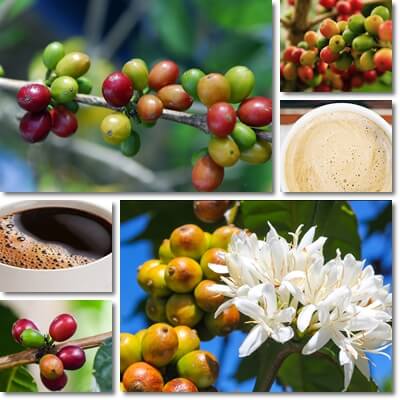Did you know that drinking coffee is good for tension headaches and raises abnormally low blood pressure numbers? Did you know that coffee beans are actually the seeds of the coffee fruit? Did you know that coffee fruit are called coffee cherries and have a sweet taste? Did you know you can make flour from coffee fruit? Discover 42 cool facts about coffee, the beverage and the plant.
List of cool facts about coffee
- Coffee is the common name for both the brew and the plant from which the brew is made.
- The name of the brew, coffee, is derived from the scientific name for the coffee plant which is Coffea.
- There are over a hundred different species of coffee plant. The most common species of coffee used to make the brew with the same name are Coffea Arabica, Coffea Robusta and Coffea liberica.

- The coffee plant is classified as a shrub or small tree.
- Coffee plants do not tolerate frost which means they are cultivated in warmer climates only.
- Depending on where it’s cultivated, coffee produces fruit during one season or can have more than one season.
- The coffee plant is a flowering plant, meaning it produces flowers.
- Fruit called coffee berries or coffee cherries develop from coffee flowers.
- Coffee cherries are not real cherries, or berries – botanically they are drupes or stone fruit like cherries, plums, apricots, peaches, nectarines, almonds, mangoes, olives, loquats, jujube fruit and coconut.
- Coffee fruit are bright green when unripe, but change color and turn yellow then red and purple as they ripen. Some varieties of coffee have yellow, orange or pink fruit when ripe.
- Coffee cherries are edible and safe to eat raw or processed.
- Coffee cherries are sweet and flavorful and do not taste like roasted coffee beans at all. The fruit have a floral, perfumed aroma reminiscent of jasmine (Arabica coffee was once called Jasminum arabicum) and taste sweet and fruity with mango and berry flavors.

- Coffee cherries have very little pulp.
- Coffee cherry skin is rich in pigmented antioxidants.
- The pulp of coffee cherries contains mucilage with benefits for gut health.
- Coffee fruit naturally have caffeine.
- Coffee, the drink, is made from the seeds of coffee fruit called coffee beans.
- Coffee beans are not real beans – botanically, they are seeds.
- There are typically two coffee beans per fruit, but some species of coffee plant only have one seed or coffee bean per fruit – these species are called peaberry coffee.
- Coffee beans look like beans, flattened on one side and rounded on the other.
- Coffee beans are only dark brown after roasting – fresh coffee beans are cream colored.
- Coffee is made from roasted coffee beans that are then finely ground and brewed.
- You can make coffee by boiling, infusing or steeping ground coffee beans. You can also make coffee from fermented coffee beans and unripe, green coffee beans.
- You can drink coffee every day and it’s not just safe to do so, but also good for you. Studies show coffee consumption lowers risks of type 2 diabetes and certain cancers, and can even help protect against Parkinson’s and Alzheimer’s disease.
- Different species of coffee naturally have different levels of caffeine. Arabica coffee is naturally lower in caffeine than Robusta coffee.
- Arabica coffee is deemed superior to Robusta coffee.
- Coffee beans come in different roast levels – coffee roast levels impact flavor.
- The taste of coffee is roughly the same across species, that is, varying degrees of bitter and acidic.
- Robusta coffee typically has a stronger bitter taste than Arabica coffee.
- Coffee tastes bitter and acidic, but has different flavors depending on the species, region of cultivation, degree of processing and brewing method.
- The different flavors perceived in coffee are actually aromas resulting from organic volatile and aromatic compounds that give brewed coffee a range of different flavors.
- Coffee flavors include:
– smoky, woody, tobacco like flavors
– spicy flavors
– fruity and floral flavors
– herbal flavors, especially noticeable in green coffee
– caramel, malt and honey flavors
– biscuit like flavors
– dry fruit flavors
– chocolate flavors
- Coffee can taste sweet too – when drying coffee beans, you can leave all or part of the actual fruit on the beans. The more fruit on the beans, the more sweet flavor notes in brewed coffee.
- Organic volatile and aromatic compounds that are responsible for the great organoleptic range of different varieties of coffee are also a source of benefits for health.
- Caffeine in coffee is the primary biologically active compound and it’s a source of both benefits and side effects.
- Caffeine is not unique to coffee – some teas also contain caffeine, called theine when it comes from herbal teas. E.g. green tea, black tea, white tea.
- Coffee is safe to drink and you can have coffee every day unless there are contraindications because of existing health issues. Up to 2-4 cups of coffee a day is a healthy amount.
- You can make coffee flour from coffee and there are two kinds: coffee flour made from coffee beans, and coffee flour made from coffee fruit (cherries).
- The coffee industry uses pesticides on coffee plants. Robusta coffee is typically sturdier and requires less pesticides compared to Arabica.
- Coffee plantations are negatively impacted by climate change and production may reduce as time goes by.
- Brewed coffee is full of antioxidants with scientifically proven biological effects such as chlorogenic acid .
- Brewed coffee is a beverage, a functional food with therapeutic effects, natural stimulant, herbal remedy and medicine. For example, caffeine in coffee raises abnormally low blood pressure levels and helps treat headaches such as tension headaches and even helps with migraines in some people.
